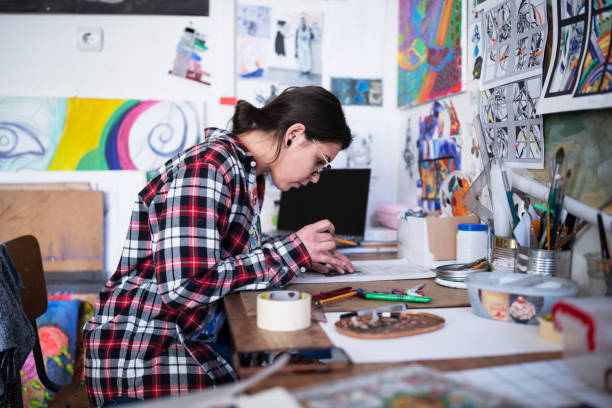If you’re about to head off to University, you might be feeling extremely overwhelmed and underprepared. But, don’t panic, because often many students buy so much equipment that they will never use. So, only buy what you need, when you need it.
Heading to art university is an exciting step toward honing your craft and developing your skills as an artist. But before you dive into your creative journey, it’s essential to have the right equipment to help you succeed. From basic tools to specialised gear, here’s a guide to the essential equipment you’ll need for art university.
1. Sketchbooks and notebooks
A good sketchbook is a must-have for any art student. Sketchbooks are perfect for jotting down ideas, practising techniques, and developing your concepts. They come in various sizes, so choose one that suits your style—whether you prefer large pages for detailed work or a pocket-sized book for quick sketches on the go. Notebooks are also essential for taking notes during lectures, writing down feedback, and keeping track of assignments.
Recommended: Invest in a few different sketchbooks for various purposes—one for rough ideas, another for refined sketches, and a notebook for academic notes.
2. Drawing and painting supplies
Depending on your focus, you’ll need a range of drawing and painting supplies. Basic items include pencils (various grades), charcoal, ink pens, rubbers, and a range of brushes. For painting, you might need watercolours, acrylics, or oils, along with a palette for mixing colours. Don’t forget to stock up on quality paper or canvas suited to your medium of choice.
Recommended: Start with a basic set of pencils, brushes, and paints, then expand as you find your preferred mediums. A set of high-quality, artist-grade supplies will last longer and perform better than cheaper alternatives.
3. A Quality laptop or tablet
A reliable laptop or tablet is crucial, especially if you’re studying digital art, graphic design, or multimedia. Look for devices that can handle creative software like Adobe Creative Cloud, Procreate, or AutoCAD. A tablet with a stylus, like an iPad Pro or a Wacom tablet, can be invaluable for sketching, illustrating, and editing.
Recommended: Ensure your laptop has sufficient RAM and storage, along with a good graphics card if you plan to work with heavy design software. Tablets should have a responsive stylus and pressure sensitivity for precision work.
4. Digital camera or smartphone with a good camera
Whether for capturing reference images, documenting your work, or creating content for your portfolio, a camera is an essential tool. While a professional DSLR or mirrorless camera is ideal, a smartphone with a high-quality camera can also do the job for most purposes. Ensure it has good resolution and the ability to adjust settings like exposure, focus, and white balance.
Recommended: A camera with manual settings will give you more control over your images, which is beneficial when documenting your artwork for submissions or your portfolio.
5. Portfolio case or digital portfolio
As an art student, you’ll need a way to showcase your work, whether for critiques, exhibitions, or job interviews. A physical portfolio case is essential for transporting drawings, prints, and paintings. For digital work, consider creating a digital portfolio that can be easily shared online or presented on a tablet during meetings.
Recommended: Invest in a sturdy, professional-looking portfolio case. For digital portfolios, platforms like Behance or Adobe Portfolio can help you present your work online.
6. Art storage and organisation supplies
Art supplies can quickly become disorganised if not stored properly. Invest in containers, folders, and storage boxes to keep your workspace tidy and your materials accessible. A tackle box or drawer system can help organise paints, brushes, and smaller tools, while a sturdy tube can protect large drawings or posters.
Recommended: Clear storage bins and drawer systems allow you to see your supplies at a glance, making it easier to keep track of everything.
7. Cutting tools and safety gear
Cutting mats, X-Acto knives, scissors, and a steel ruler are essential for any art student, especially those working in design, sculpture, or mixed media. Always have safety gear on hand, such as gloves, goggles, and aprons, to protect yourself during messy or potentially hazardous projects.
Recommended: Invest in self-healing cutting mats and precision knives for accurate and safe cutting. Don’t overlook safety gear, especially when working with chemicals, power tools, or sharp objects.
8. Storage for digital files
As a student, you’ll accumulate a large number of digital files, from project drafts to completed works. Make sure you have reliable storage solutions, such as external hard drives or cloud storage services like Google Drive, Dropbox, or Adobe Creative Cloud, to back up your work and keep it organised.
Recommended: Regularly back up your work to avoid losing valuable files. A combination of cloud and physical storage will give you peace of mind.
Preparing for art university means equipping yourself with the right tools to support your creative journey. While the basics—like sketchbooks, paints, and pencils—are a given, investing in quality digital tools, organisation systems, and protective gear can make your studies more efficient and enjoyable.
As you progress in your studies, continue to refine your equipment to suit your evolving needs and artistic style. With the right tools in hand, you’ll be well-prepared to make the most of your time at art university. Be prepared, but don’t over-do it. Otherwise, you’ll find you spend money on things you really don’t need.




